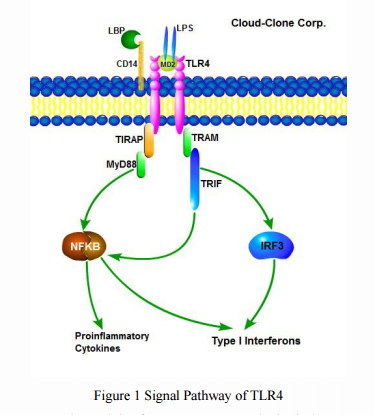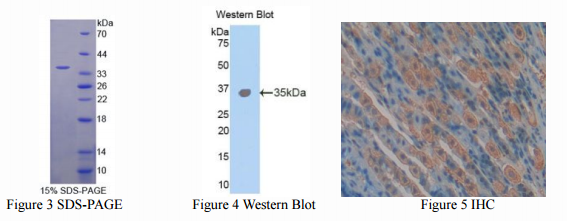TLR4 (Toll like receptor 4) - Receptor of LPS of Bacteria
Toll-like receptor 4 (TLR4) is a kind of type I transmembrane protein discovered by Poltorak in 1998. It is coded by TLR4 gene, and expressed on several kinds of cells, including monocytes, macrophages et al. TLR4 could recognize lipopolysaccharide (LPS) from gram negative bacteria, and then trigger signal transduction through NF-κB or JNK/SAPK pathway (Fig.1) (more information about LPS related products, please check http://www.uscnk.com/topic/LPS-ELISA-Kit-may-Substitute- for-LAL-Test.html).
Innate immunity (also known as native immunity) refers immunity created during species evolution development. It appears at birth of the individual, and it functions in a broad range not specifically to certain antigens. Innate immunity shows significant importance in the body's defense mechanisms, which functions as the first line of defense against pathogenic microbial infection. It is reported that TLR4 plays an important role in innate immunity through directly recognize pathogen associated molecular pattern (PAMP) including LPS, lipoteichoic acid (LTA) , dsRNA, et al. In recent years, TLR4 was researched in inflammation, anti-viral infection, cancer treatment and immune response regulation.

The common used models for TLR4 research include in-vivo and in-vitro models, mouse model is broadly used for in-vivo research. So, the company had done a lot of researches in the development of mouse TLR4 reagents, and several products were pushed into the market, for instance, recombinant protein of mouse TLR4, RPA753Mu01, the sequence of this protein is chosen through topological structural analysis and epitopes analysis, the expressive sequence includes amino acids of Asn26~Glu269, which is the extra-cellular part of the protein, the sequence of this recombinant protein is shown in Fig.2, and pic of SDS-PAGE is shown in Fig.3.

Then, the recombinant protein of RPA753Mu01 was used for immunization of rabbit, and the serum was purified through antigen-specific affinity chromotography to acquire antibody with high concentration and purity, the result of Western Blot and IHC test of PAA753Mu01 are shown in Fig.4 and Fig.5. In the meanwhile, this antibody was coupled with several kinds of labels, for instance, botin and FITC. Then biotin, FITC labeled polyclonal antibody specific to mouse TLR4 (PAA753Mu71, PAA753Mu81) were generated.

The origin of mouse TLR4 is mouse. Due to the limit of immunity in certain species, mouse could not be used as immune animal while preparing monoclonal antibody of this protein. Based on this, the company will prepare monoclonal antibody specific to mouse TLR4 by technique from the on-going research project of Research of Rat Monoclonal Antibody. The products are under development right now, please pay continuous attention to it.
As for human TLR4, the recombinant protein of RPA753Hu01 includes amino acids of Phe326~Ile634, and it was used to prepare polyclonal antibody of PAA753Hu01 and monoclonal antibody of MAA753Hu22 with high purity and specificity, all these products were verified by WB, IHC and ELISA.
Besides of the products mentioned above, ELISA kits for quantitative detection of TLR4 from different species (SEA753Hu, SEA753Mu, SEA753Ra) were used in several research projects, and references are shown in Table 1.
Table 1 References of ELISA Kits for TLR4 Detection
| Catalog | Magazine | Article |
| SEA753Mu | PLoS One | Baicalein Reduces Airway Injury in Allergen and IL-13 Induced Airway Inflammation (PubMed: PMC3639905) |
| SEA753Hu | Journal of Maternal-Fetal and Neonatal Medicine | Amniotic fluid soluble Toll-like receptor 4 in pregnancies complicated by preterm prelabor rupture of the membranes (Informa: 14767058.2011.626821) |
| SEA753Hu | Journal of Maternal-Fetal and Neonatal Medicine | Amniotic fluid soluble Toll-like receptor 4 in pregnancies complicated by preterm prelabor rupture of the membranes (Informa: 14767058.2011.626821) |
| SEA753Hu | Clin Res Hepatol Gastroenterol. | The association between precancerous gastric lesions and serum pepsinogens, serum gastrin, vascular endothelial growth factor, serum interleukin-1 Beta, serum toll-like receptor-4 levels and Helicobacter pylori Cag A status (Pubmed: 23137754) |
| SEA753Hu | Chinese Medical Journal | Expression of soluble Toll-like receptors in pleural effusions (CMJ: 2010823483999506297) |
| SEA753Ra | Surgical Endoscopy | CO2 pneumoperitoneum increases secretory IgA levels in the gut compared with laparotomy in an experimental animal model. Read more(Pubmed: 24442682) |
For more information about TLR4 related proteins, antibodies and quantitative detection kits from other species, please visit http://www.cloud-clone.us/.
